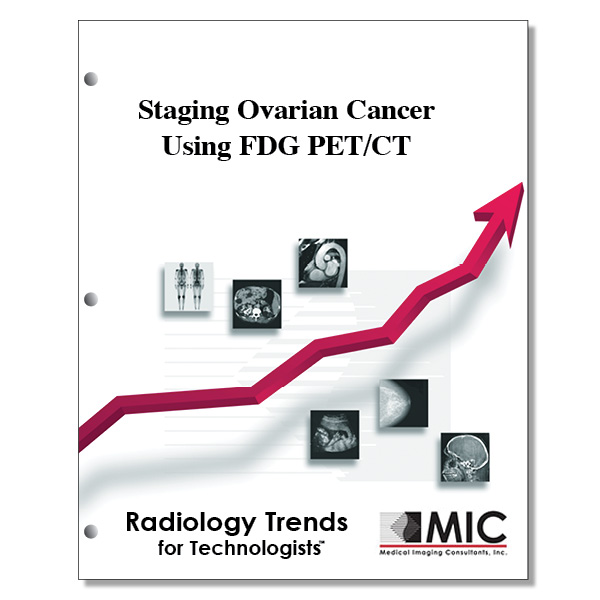

Staging Ovarian Cancer Using FDG PET/CT
A presentation of the role of FDG PET combined with CT plays in depicting recurrent ovarian cancer.
Course ID: Q00320 Category: Radiology Trends for Technologists Modalities: CT, Nuclear Medicine, PET2.5 |
Satisfaction Guarantee |
$29.00
- Targeted CE
- Outline
- Objectives
Targeted CE per ARRT’s Discipline, Category, and Subcategory classification:
[Note: Discipline-specific Targeted CE credits may be less than the total Category A credits approved for this course.]
Computed Tomography: 1.00
Procedures: 1.00
Abdomen and Pelvis: 1.00
Magnetic Resonance Imaging: 1.00
Procedures: 1.00
Body: 1.00
Nuclear Medicine Technology: 2.00
Procedures: 2.00
Endocrine and Oncology Procedures: 2.00
Registered Radiologist Assistant: 2.50
Patient Care: 0.50
Patient Management: 0.50
Procedures: 2.00
Abdominal Section: 2.00
Sonography: 1.00
Procedures: 1.00
Gynecology: 1.00
Radiation Therapy: 2.00
Patient Care: 1.00
Patient and Medical Record Management: 1.00
Procedures: 1.00
Treatment Sites and Tumors: 1.00
Outline
- Introduction
- Ovarian Cancer
- Patterns of Spread of Ovarian Cancer
- Imaging of Recurrent Ovarian Cancer
- PET/CT Findings of Ovarian Cancer Metastases
- Peritoneal Metastases
- Lymph Node Metastases
- Distant Organ Metastases
- Evaluation of Response to Therapy
- Pitfalls of PET/CT
- Conclusions
Objectives
Upon completion of this course, students will:
- be familiar with the most common causes of mortality in women with gynecological cancers
- be familiar with initial treatments for ovarian cancer
- be familiar with recurrence rate in women in ovarian cancer (post-surgical)
- understand why PET/CT may be a useful diagnostic techniques for detection of ovarian cancer recurrence
- understand which diagnostic techniques may have limited predictive value in the identification of ovarian cancer recurrence
- understand the advantages of FDG PET/CT for the detection of ovarian cancer recurrences
- understand that ovarian cancer is a malignancy that is frequently diagnosed at an advanced stage, that is, in three-quarters of women with ovarian cancer
- be familiar with the five-year survival rates for patients with early stage and advanced stage disease
- understand that the cornerstone of management for women with ovarian cancer is surgery
- be familiar with the guidelines of the National Comprehensive Cancer Network for the diagnosis of ovarian cancer
- be familiar with the treatment modalities that can prolong survival in women with recurrent ovarian cancer
- be familiar with the path of tumor metastasis via lymph nodes
- be familiar with the proportion of patients with Stages I, II, III-IV ovarian cancer malignancies with lymph node involvement
- be familiar with difficulties in identifying small ovarian cancer metastasis
- be familiar with sensitivity of FDG PET/CT for detection of recurrent cancer
- be familiar with the specificity of FDG PET/CT for detection of recurrent cancer
- be familiar with the sensitivity of MRI for the detection of recurrent cancer
- be familiar with the specificity of MRI for the detection of recurrent cancer
- understand how metabolic activity with FDG PET/CT imaging allows visualization of peritoneal metastases
- be familiar with the type of fluid vessel or vasculature or circulation that carries metastatic ovarian tumor cells
- be familiar with at least three of the structures to which peritoneal fluid carries metastatic tumor cells
- be familiar with the percentage of patients in whom gravity facilitates spread of malignancy
- be familiar with how ovarian cancer tumor cells seed the sigmoid mesocolon
- understand the definition of Sister Mary Joseph nodules
- be familiar with how retained embryofetal structures with residual patency may provide routes of metastasis
- be familiar with how often lymphatic dissemination occurs in women with early stage ovarian cancer
- understand which types of lymph node ovarian cancer metastases are not well detected with FDG PET/CT
- be familiar with common findings on FDG PET/CT in stage IV (advanced) ovarian cancer
- be familiar with the sensitivity of FDG PET/CT for detecting distant metastasis
- be familiar with which diagnostic techniques work for assessing response to therapy
- be familiar with how FDG PET/CT findings can predict overall survival of women with ovarian cancer
- be familiar with the characteristics which may complicate FDG PET/CT response assessment in ovarian cancer patients who have been administered chemotherapy
- understand which characteristics may complicate FDG PET/CT response assessment independent of treatment modality
- understand that caution in interpreting FDG PET/CT findings needs to be exercised for at least 6 months post-surgery
- understand the role of FDG PET/CT when other studies such as MRI are negative
